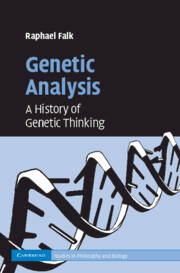Book contents
- Frontmatter
- Contents
- List of figures
- Acknowledgments
- Introduction
- PART I FROM REPRODUCTION AND GENERATION TO HEREDITY
- PART II FAKTOREN IN SEARCH OF MEANING
- PART III THE CHROMOSOME THEORY OF INHERITANCE
- PART IV GENES AS THE ATOMS OF HEREDITY
- PART V INCREASING RESOLVING POWER
- PART VI DEDUCING GENES FROM TRAITS, INDUCING TRAITS FROM GENES
- 14 How do genes do it?
- 15 The path from DNA to protein
- 16 Genes in the service of development
- PART VII WHAT IS TRUE FOR E. COLI IS NOT TRUE FOR THE ELEPHANT
- Concluding comments
- Bibliography
- Index
15 - The path from DNA to protein
Published online by Cambridge University Press: 07 August 2009
- Frontmatter
- Contents
- List of figures
- Acknowledgments
- Introduction
- PART I FROM REPRODUCTION AND GENERATION TO HEREDITY
- PART II FAKTOREN IN SEARCH OF MEANING
- PART III THE CHROMOSOME THEORY OF INHERITANCE
- PART IV GENES AS THE ATOMS OF HEREDITY
- PART V INCREASING RESOLVING POWER
- PART VI DEDUCING GENES FROM TRAITS, INDUCING TRAITS FROM GENES
- 14 How do genes do it?
- 15 The path from DNA to protein
- 16 Genes in the service of development
- PART VII WHAT IS TRUE FOR E. COLI IS NOT TRUE FOR THE ELEPHANT
- Concluding comments
- Bibliography
- Index
Summary
In their short paper of April 25, 1953, Watson and Crick introduced their model of the structure of DNA. Although this is a presentation of a physico-chemical model, and the authors make “the usual chemical assumptions,” they emphasize that “The structure has novel features which are of considerable biological interest.”
The structure has two helical chains each coiled round the same axis. … The novel feature of the structure is the manner in which the two chains are held together by purine and pyrimidine bases. … They are joined together in pairs … adenine (purine) with thymine (pyrimidine), and guanine (purine) with cytosine (pyrimidine). … The sequence of bases on a single chain does not appear to be restricted in any way. However, if only specific pairs of bases can be formed, it follows that if the sequence of bases on one chain is given, then the sequence on the other chain is automatically determined.
Watson and Crick (1953b)The authors notice that the model appears to be “roughly compatible with the experimental data, but it must be regarded as unproven until it has been checked against more exact results.” Nevertheless, in the final paragraph they state that it “has not escaped our notice that the specific pairing we have postulated immediately suggests a possible copying mechanism for the genetic material” (Watson and Crick, 1953b).
- Type
- Chapter
- Information
- Genetic AnalysisA History of Genetic Thinking, pp. 220 - 230Publisher: Cambridge University PressPrint publication year: 2009



